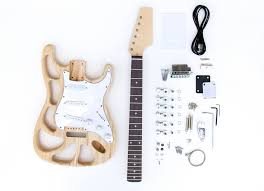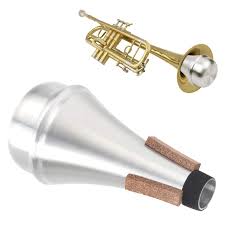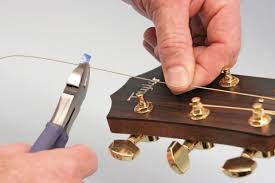Exploring the World of Kit Guitars
Kit guitars, also known as DIY guitar kits, have been gaining popularity among music enthusiasts and aspiring luthiers. These kits provide musicians with the opportunity to build their own custom guitars from scratch, allowing for a unique and personalised instrument that suits their style and preferences.
One of the main attractions of kit guitars is the sense of accomplishment and satisfaction that comes from building your own musical instrument. It offers a hands-on experience that allows musicians to understand the inner workings of a guitar and develop a deeper connection with their instrument.
Kit guitars come in various styles and designs, ranging from classic electric guitars to acoustic models. They typically include all the necessary components such as body, neck, hardware, and electronics, along with detailed instructions for assembly. This makes it accessible even for beginners with no prior woodworking experience.
Building a kit guitar can be a creative and rewarding process. Musicians have the freedom to choose their preferred wood types, finishes, and hardware to create a truly one-of-a-kind instrument. It also opens up opportunities for customisation and modification, allowing players to tailor their guitar to meet their specific playing needs.
Furthermore, kit guitars are often more affordable than purchasing a pre-built instrument of similar quality. This makes them an attractive option for budget-conscious musicians who are looking for a high-quality guitar without breaking the bank.
In addition to being cost-effective, kit guitars offer a valuable learning experience for those interested in guitar construction and repair. Assembling a kit guitar can provide insights into the mechanics of an instrument and help develop skills in setup, maintenance, and troubleshooting.
Whether you’re a seasoned guitarist looking for a new project or a beginner eager to delve into the world of lutherie, kit guitars offer an exciting avenue for creativity and self-expression. With endless possibilities for customisation and personalisation, building your own guitar from a kit is not just about creating music – it’s about crafting an instrument that resonates with your passion and personality.
8 Essential Tips for Building Your Perfect Kit Guitar
- Choose a kit guitar that matches your skill level.
- Read and follow the assembly instructions carefully.
- Ensure you have all the necessary tools before starting the assembly.
- Take your time and don’t rush the building process.
- Sand down any rough edges for a smooth finish.
- Test fit components before gluing or screwing them in place.
- Consider customising your kit guitar with unique paint or hardware upgrades.
- Seek help from online forums or tutorials if you encounter any difficulties.
Choose a kit guitar that matches your skill level.
When embarking on the journey of building a kit guitar, it is crucial to select a kit that aligns with your skill level. Choosing a kit guitar that matches your expertise ensures a smooth and enjoyable building process, allowing you to focus on honing your craftsmanship and attention to detail. For beginners, opting for a kit with clear instructions and basic assembly requirements can provide a solid foundation for learning the fundamentals of guitar construction. On the other hand, experienced builders may seek more complex kits that offer opportunities for advanced techniques and customisation. By selecting a kit guitar that suits your skill level, you can enhance your building experience and create a high-quality instrument that reflects your capabilities as a luthier.
Read and follow the assembly instructions carefully.
When embarking on the journey of building a kit guitar, it is crucial to heed the advice of reading and meticulously following the assembly instructions provided. These instructions serve as a roadmap for assembling the components correctly and ensuring that the final instrument functions optimally. By paying close attention to the details outlined in the instructions, builders can avoid common pitfalls, ensure proper alignment of parts, and ultimately achieve a successful build that results in a high-quality guitar that plays beautifully.
Ensure you have all the necessary tools before starting the assembly.
Before embarking on the assembly of your kit guitar, it is crucial to ensure that you have all the necessary tools at hand. Having the right tools for the job will not only make the assembly process smoother and more efficient but also help you achieve a professional finish. Common tools required for building a kit guitar include screwdrivers, wrenches, pliers, sandpaper, and clamps. By being well-prepared with the essential tools, you can tackle any challenges that may arise during the assembly and enjoy a rewarding experience of creating your own custom instrument.
Take your time and don’t rush the building process.
When it comes to building kit guitars, one crucial tip to keep in mind is to take your time and not rush the building process. Building a guitar from a kit requires patience, precision, and attention to detail. Rushing through the assembly can lead to mistakes that may affect the playability and overall quality of the instrument. By taking your time, carefully following instructions, and double-checking your work at each step, you can ensure that your kit guitar turns out beautifully crafted and ready to deliver exceptional sound quality. Remember, the journey of building your own guitar is just as rewarding as the final result, so enjoy the process and savour every moment of creating your unique musical masterpiece.
Sand down any rough edges for a smooth finish.
When assembling a kit guitar, it is crucial to pay attention to detail and ensure a professional finish. One essential tip is to sand down any rough edges meticulously to achieve a smooth surface. By carefully smoothing out imperfections, you not only enhance the visual appeal of the instrument but also improve its playability. A seamless finish not only adds to the aesthetic charm of the guitar but also contributes to a comfortable playing experience, making it a joy for musicians to strum their custom-built masterpiece.
Test fit components before gluing or screwing them in place.
When working on kit guitars, it is crucial to test fit components before permanently securing them in place with glue or screws. This step ensures that all parts align correctly and function smoothly once assembled. By checking the fit of each component beforehand, builders can identify any potential issues or adjustments needed before final assembly. Taking the time to test fit components helps prevent costly mistakes and ensures a professional-looking finished instrument.
Consider customising your kit guitar with unique paint or hardware upgrades.
When building your kit guitar, it’s worth considering customising it with unique paint or hardware upgrades to make it truly your own. Adding a personal touch through custom paint finishes or upgrading the hardware can transform your instrument into a one-of-a-kind masterpiece that reflects your individual style and personality. Whether you opt for bold colours, intricate designs, or premium hardware enhancements, these customisations can elevate your kit guitar from a DIY project to a personalised work of art that stands out on stage and in your collection.
Seek help from online forums or tutorials if you encounter any difficulties.
When building a kit guitar, it is advisable to seek help from online forums or tutorials if you encounter any difficulties. Online communities and resources can provide valuable guidance, tips, and troubleshooting advice to assist you in overcoming challenges during the assembly process. By tapping into the collective knowledge and experience of fellow enthusiasts, you can navigate any obstacles with confidence and ensure that your kit guitar project progresses smoothly towards completion.






